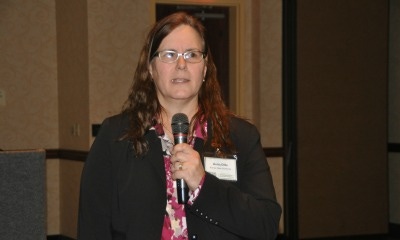
When it comes to weed control, many producers are finding themselves headed back to the pre-1996 days of site-specific weed control, even if that sometimes means tillage, Kansas State University agronomist Anita Dille told members of the Kansas Agricultural Research and Technology Association during its annual convention in January.
"We are now officially past the easy weed management that we enjoyed for a decade and a half after Roundup Ready," she said. "Now, we need to work a lot harder at weed control."
That means integrated weed management programs, site-specific weed management and multiple practices, she said.

WEED ISSUES: Anita Dille with Kasnsas State Univeristy talks about site-specific weed control the annual Kansas Ag Research and Technology conference.
"For years, you just sprayed Round-up and if you had a weed here and there, no big deal," she said. "Turns out that over time, it's a very big deal. Now we need to watch carefully. If you have a little patch here or there where you didn't get complete control, you need to go in there and get them."
Undertaking site-specific weed control requires information on the field and the distribution of weeds in it, she said.
"You need to know what weeds, where they are in the field and the soil characteristics of the weed patch, along with topography, soil texture, organic matter content and pH," she said. "That data is going to enable you to know what herbicides are going to be the most effective in the spot where you have the problem."
Targeting a herbicide application to the specific weed and location of that weed allows you to control just the problem without the expense of treating the whole field, she said.
Problem weeds often show up in patches, she said, because in well-managed fields, seed dispersal tends to be close to the parent plant.
"You have to keep in mind, though, that weed seed can survive a long time. You many have an area that is a persistent seed bank or you may even have a perennial weed," she said. "If you have a persistent seed bank, it may take several years of treating that patch before you get rid of it."
Remote sensing can help farmers map the areas of the field that may have a weed problem when the weeds are still small enough that you can get effective control, she said.
"There is technology that can tell a weed from a desirable plant at coddling stage, when it is too small for you to be able to easily identify it," she said. "The key is getting that imaging done and processed in a timely manner."
Various factors can influence how effective a given herbicide treatment will be, she said.
Herbicide can break down in sunlight, can end up as runoff from a high-rain event, can drift on the wind or break down in the soil, she said.
The reality is herbicide applications are no longer as simple as they were in 1996 when you just sprayed Roundup and that fixed it, Dille said. Now, producers are back to pre-1996 and we're looking at a far more complicated problem.
About the Author(s)
You May Also Like






